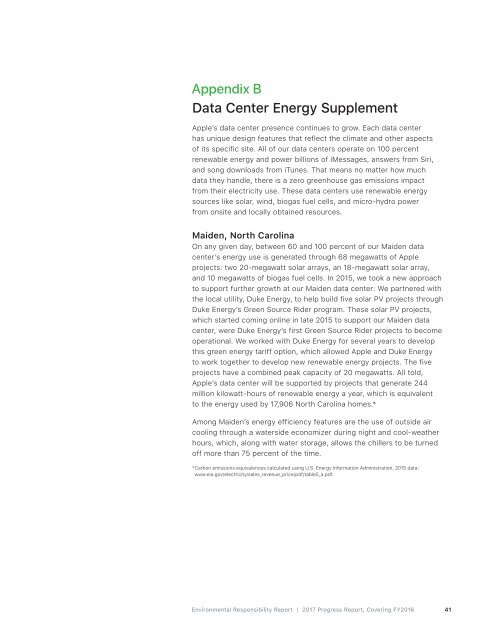Apple Environmental Responsibility Report
Create successful ePaper yourself
Turn your PDF publications into a flip-book with our unique Google optimized e-Paper software.
Appendix B<br />
Data Center Energy Supplement<br />
<strong>Apple</strong>’s data center presence continues to grow. Each data center<br />
has unique design features that reflect the climate and other aspects<br />
of its specific site. All of our data centers operate on 100 percent<br />
renewable energy and power billions of iMessages, answers from Siri,<br />
and song downloads from iTunes. That means no matter how much<br />
data they handle, there is a zero greenhouse gas emissions impact<br />
from their electricity use. These data centers use renewable energy<br />
sources like solar, wind, biogas fuel cells, and micro-hydro power<br />
from onsite and locally obtained resources.<br />
Maiden, North Carolina<br />
On any given day, between 60 and 100 percent of our Maiden data<br />
center’s energy use is generated through 68 megawatts of <strong>Apple</strong><br />
projects: two 20-megawatt solar arrays, an 18-megawatt solar array,<br />
and 10 megawatts of biogas fuel cells. In 2015, we took a new approach<br />
to support further growth at our Maiden data center: We partnered with<br />
the local utility, Duke Energy, to help build five solar PV projects through<br />
Duke Energy’s Green Source Rider program. These solar PV projects,<br />
which started coming online in late 2015 to support our Maiden data<br />
center, were Duke Energy’s first Green Source Rider projects to become<br />
operational. We worked with Duke Energy for several years to develop<br />
this green energy tariff option, which allowed <strong>Apple</strong> and Duke Energy<br />
to work together to develop new renewable energy projects. The five<br />
projects have a combined peak capacity of 20 megawatts. All told,<br />
<strong>Apple</strong>’s data center will be supported by projects that generate 244<br />
million kilowatt-hours of renewable energy a year, which is equivalent<br />
to the energy used by 17,906 North Carolina homes.*<br />
Among Maiden’s energy efficiency features are the use of outside air<br />
cooling through a waterside economizer during night and cool-weather<br />
hours, which, along with water storage, allows the chillers to be turned<br />
off more than 75 percent of the time.<br />
*Carbon emissions equivalences calculated using U.S. Energy Information Administration, 2015 data:<br />
www.eia.gov/electricity/sales_revenue_price/pdf/table5_a.pdf.<br />
<strong>Environmental</strong> <strong>Responsibility</strong> <strong>Report</strong> | 2017 Progress <strong>Report</strong>, Covering FY2016<br />
41







